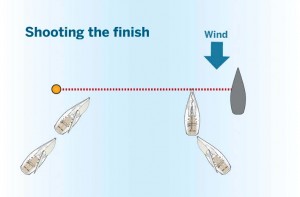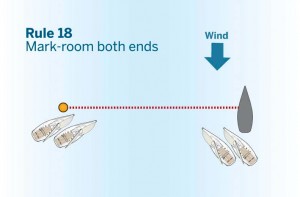Sailing to win – how to win a race and ensure you cross the line first. Tips by top match racer Ian Williams
Although the start line of a competitive fleet can be an adrenalin-fuelled arena, with well-versed crews showing off their prowess, the end of a race can be just as tough. Energy levels may be running low, concentration might slip, but the final leg of the race may provide a perfect opportunity to snatch a result.
Capping a good race begins with knowing the basics and taking nothing for granted. For example, finishes at a fixed mark may not specify a side, only that you must pass between a particular buoy and the race committee finish boat. So being alert is vital, particularly if other craft in the area of the finish line are confusing the scene.
Positive thinking, clear tactics and concentration are critical. Assuming you’re not in a head-to-head finish line showdown with one-design rivals, sailors in handicap fleets can keep crew morale high by minimising the time lost and by maximising the chances of success when the corrected times are displayed.
1. Make sure you know the course and where the finish line is located. The finish is normally defined in the Sailing Instructions, but is often not very well-described when the race committee reads out the course. Make sure you know how to identify the finish line and have noted any peculiarities in the SIs, particularly which is your finish if there are multiple finish lines.
2. This is hard to judge as you approach, so try to get a bearing when you pass the finish line during the race. If that is not possible, consider approaching the finish in a way that allows you to make a late decision about which end to go for – tacking for the line as soon as you can lay it will help to leave your options open.
3. Decide what your tactics on the final leg to the finish need to be. It is important to know what you have to achieve. If you are handicap racing, you should assess which boats you are close to on corrected time and what you need to do to beat them. In level rating racing, consider whether you are attacking or defending, or you may be clear enough of other boats to start preparing for the next race.
4. Remember RRS 18 (Mark-Room) applies at the finish (unlike at the start), so a boat inside at a finish mark or boat is entitled to room. The rules also apply until any boats involved in an incident have cleared the line, so in close situations make sure you have done so before relaxing. Rules 28.1 (Sailing the Course) and 31 (Touching a Mark) are worth keeping in mind too; the latter would require a single penalty turn and a re-finish unless specified differently in the Sailing Instructions.
5. In close races, vital seconds can be gained by luffing head to wind (or dialling down on a downwind finish) right at the finish line. Upwind you close the line at about 1.3 times faster head to wind than you do sailing at 40° true, so as long as you do not drop below about three-quarters of your upwind speed, you will be gaining time.
Ian Williams is a four-times ISAF Match Racing World Champion and the only European to hold multiple match racing world titles. He has won the World Match Racing Tour ten times. Williams is also well-known on the professional big boat circuit as a tactician, having won regattas in many different classes and has been shortlisted twice for the ISAF World Sailor of the Year award and twice for the British Yachtsman of the Year award
This is an extract from a feature in Yachting World July 2014






